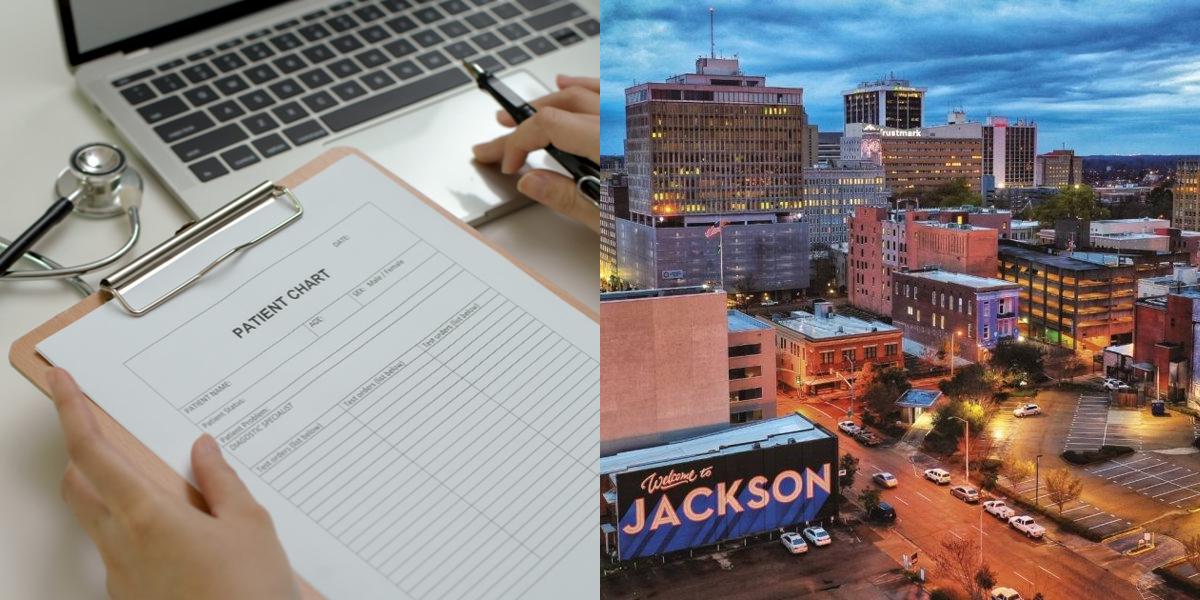How to Become a Medical Transcriptionist in Mississippi
SearchMedical Transcriptionist
classes near 43215

If you have excellent listening and typing skills, attention to detail, and an interest in the medical field, a career as a medical transcriptionist in Mississippi might be a great fit for you. In this blog post, we will explore what medical transcriptionists do, where they work, the requirements to become one in Mississippi, and where you can find medical transcriptionist classes.
What is a Medical Transcriptionist?
A medical transcriptionist is a professional who listens to audio recordings of medical professionals and transcribes them into written documents. These documents become part of patients' medical records and are used by healthcare providers for various purposes, such as treatment plans, insurance claims, and legal documentation.
Medical transcriptionists need to have a strong understanding of medical terminology, anatomy, and physiology. They also need to be proficient in using transcription software and have excellent grammar and punctuation skills to ensure accuracy in their transcriptions.
Some of the responsibilities of a medical transcriptionist include:
- Listening to audio recordings and converting them into written documents.
- Editing and proofreading transcriptions for accuracy.
- Ensuring that transcriptions follow guidelines and formatting standards.
- Researching medical terms and procedures to ensure correct transcription.
- Maintaining patient confidentiality and adhering to privacy laws.
Where does a Medical Transcriptionist work?
Medical transcriptionists can work in a variety of settings, including:
- Hospitals and clinics: Many medical transcriptionists are employed by healthcare facilities, where they transcribe medical reports for doctors, nurses, and other healthcare professionals.
- Transcription services: Some medical transcriptionists work for specialized transcription companies that provide transcription services to healthcare providers.
- Remote work: With the advancement of technology, many medical transcriptionists now work remotely from their homes, receiving audio files electronically and delivering transcriptions online.
How to Become a Medical Transcriptionist in Mississippi?
To become a Medical Transcriptionist in Mississippi, one must first complete an accredited education program, typically a certificate or diploma course. After obtaining the necessary certification, individuals can then search for job opportunities in healthcare facilities, clinics, or transcription service companies to start earning a competitive salary.
Requirements to become a Medical Transcriptionist in Mississippi
To become a medical transcriptionist in Mississippi, you will need to meet certain educational and legal requirements. These include:
-
Education: While a high school diploma is the minimum requirement, most employers prefer candidates who have completed a vocational training program in medical transcription. These programs typically last between 6 months to 1 year and cover topics such as medical terminology, anatomy, transcription techniques, and computer skills.
-
Legal requirements: Some employers may require medical transcriptionists to be certified by a recognized professional organization, such as the Association for Healthcare Documentation Integrity (AHDI). Certification demonstrates proficiency in medical transcription and can enhance job prospects.
Exploring a Career in Medical Transcriptionist Outside Mississippi
If you're aiming to pursue a career as a Medical Transcriptionist but find yourself in a different state, remember, your goal is still within reach. You can explore opportunities to start your career as a Medical Transcriptionist in places like Florida, Indiana, North Dakota, Utah, or West Virginia. If these locations don't work for you, Dreambound simplifies the journey to becoming a Medical Transcriptionist no matter where you live. By enabling you to find and compare Medical Transcriptionist classes with a search by zip code, Dreambound empowers you to move forward confidently towards a rewarding career in healthcare, regardless of your current location.
Get courses selected just for you
Try our powerful search engine
How do I get my Medical Transcriptionist certification?
If you are interested in pursuing a career in medical transcription, obtaining a certification is a crucial step to showcase your skills and increase your chances of landing a job in the field. Here are the steps you can take to get your medical transcriptionist certification.
-
Research the certification options: There are several organizations that offer medical transcription certification programs, such as the Association for Healthcare Documentation Integrity (AHDI) and the American Health Information Management Association (AHIMA). Before making a decision, research the requirements, cost, and reputation of each certification program.
-
Meet the eligibility criteria: Each certification program has its own eligibility criteria that you must meet in order to enroll. These criteria may include a high school diploma or equivalent, completion of a medical transcription training program, or a certain amount of work experience in the field.
-
Complete a medical transcription training program: To gain the necessary skills and knowledge required for the certification, it is recommended to complete a medical transcription training program. These programs, which can be completed online or at a vocational school, cover topics such as medical terminology, anatomy, pharmacology, transcription techniques, and electronic health records.
-
Gain practical experience: Many certification programs require a certain amount of practical experience in medical transcription. This can be obtained through internships, externships, or working as a transcriptionist in a medical setting. Practical experience is valuable as it allows you to apply your knowledge and skills in a real-world setting.
-
Prepare for the certification exam: Once you have completed your training program and gained practical experience, it is time to prepare for the certification exam. The exam typically consists of multiple-choice questions and a practical transcription test. Study guides and practice exams are available to help you prepare for the exam.
-
Take the certification exam: Schedule a date to take the certification exam. Be sure to arrive well-prepared, well-rested, and confident. The exam will assess your knowledge of medical transcription guidelines, accuracy in transcribing medical records, and understanding of medical terminology.
-
Maintain your certification: After successfully passing the certification exam, you will need to maintain your certification by fulfilling the continuing education requirements set by the certifying organization. This may include completing a certain number of continuing education units (CEUs) or participating in professional development activities.
By following these steps, you can obtain your medical transcriptionist certification and demonstrate your expertise in the field.
How do I get a job as a Medical Transcriptionist?
Once you have obtained your medical transcriptionist certification, you can start looking for job opportunities in the field. Here are some steps to help you get a job as a medical transcriptionist.
-
Prepare your resume: Craft a professional resume that highlights your certification, training, and relevant experience. Include any internships, externships, or work experience you have in medical transcription. Emphasize your attention to detail, accuracy, and knowledge of medical terminology.
-
Create a cover letter: Write a compelling cover letter that explains why you are interested in the position and how your skills and qualifications make you a good fit for the role. Customize the cover letter for each job application to demonstrate your genuine interest in the specific position.
-
Network: Tap into your personal and professional network to find job opportunities. Let friends, family, and colleagues know that you are looking for a job as a medical transcriptionist. Attend industry events, join online forums, and participate in professional networking groups to connect with professionals in the field.
-
Apply to job postings: Search for job postings on online job boards, company websites, and professional association websites. Tailor your resume and cover letter to each job application and submit them according to the instructions provided. Follow up with the employer after submitting your application to express your interest in the position.
-
Consider remote or freelance work: Many medical transcriptionists work remotely or as freelancers. Explore opportunities to work from home or on a freelance basis. Websites and platforms such as Upwork and Freelancer often have job postings for medical transcriptionists.
-
Prepare for interviews: If your application is successful, you may be invited for an interview. Research the company and familiarize yourself with their services and values. Prepare answers to common interview questions and practice your communication skills. Be ready to showcase your knowledge, skills, and experience in medical transcription.
-
Demonstrate your skills: During the interview process, you may be asked to take a transcription test to demonstrate your skills. Be prepared to transcribe a sample medical record accurately and efficiently. Pay attention to formatting, grammar, and spelling.
-
Follow up: After the interview, send a thank-you email or letter to the interviewer to express your gratitude for the opportunity. This will leave a positive impression and show your enthusiasm for the position.
By following these steps and being proactive in your job search, you can increase your chances of securing a job as a medical transcriptionist.
Career Paths and Opportunities after Becoming a Medical Transcriptionist
Once you have become a certified medical transcriptionist, there are various career paths and opportunities you can explore within the field. Here are some options to consider:
-
In-house medical transcriptionist: Many healthcare facilities, such as hospitals, clinics, and private practices, employ in-house medical transcriptionists. In this role, you would work directly for the facility, transcribing medical records and reports generated by healthcare professionals. This option provides stability and the opportunity to collaborate with a team.
-
Remote medical transcriptionist: With advancements in technology, many medical transcriptionists work remotely. Remote medical transcriptionists can work from home or any location with an internet connection. This option offers flexibility and the ability to create your own schedule. Remote work may be available through healthcare organizations or transcription service providers.
-
Freelance medical transcriptionist: Freelancing is another option for medical transcriptionists. As a freelancer, you have the freedom to choose your clients and projects. Freelancers often work with multiple clients and have more control over their workload and income. Platforms such as Upwork and Freelancer can help you find freelance opportunities.
-
Medical transcription editor: As a medical transcription editor, you would review and edit transcriptions done by other medical transcriptionists for accuracy, grammar, and formatting. This role requires strong attention to detail and knowledge of medical terminology. Medical transcription editors may work in-house or remotely.
-
Quality assurance specialist: Quality assurance specialists ensure the accuracy and quality of transcribed medical records. They review transcriptions, provide feedback to transcriptionists, and implement quality improvement measures. This role requires a deep understanding of medical terminology and transcription guidelines.
-
Medical coding specialist: Medical coding involves assigning codes to medical diagnoses, procedures, and services for billing and reimbursement purposes. Medical transcriptionists can acquire additional training in medical coding to expand their career options. This role requires knowledge of medical coding systems, such as ICD-10 and CPT.
-
Medical transcription supervisor/manager: With experience and leadership skills, you can advance to a supervisory or managerial role in medical transcription. In this role, you would oversee a team of transcriptionists, manage workflows, and ensure quality standards are met. Supervisory or managerial positions may be available in healthcare facilities or transcription service companies.
-
Education and training: If you have a passion for teaching and mentoring, you can pursue a career in education and training. Opportunities include becoming an instructor for medical transcription training programs or developing training materials for aspiring medical transcriptionists.
These are just a few examples of the career paths and opportunities available after becoming a medical transcriptionist. With experience, additional training, and continuous learning, you can further expand your options within the field.
Final Thoughts
Becoming a certified medical transcriptionist opens up a range of career opportunities in the healthcare industry. By following the steps to obtain your certification, preparing for job applications and interviews, and exploring various career paths, you can build a successful career in medical transcription. Stay updated with industry trends and continue to enhance your skills to stay competitive in the field. Good luck on your journey to becoming a medical transcriptionist!
If this article doesn't match what you're looking for, you can check out these other articles:

Harold Roldan is a Growth team member at Dreambound. With a background in IT, he works with data and automation to improve team efficiency and workflows. He spends his free time playing musical instruments or studying data, computers, and technology.
